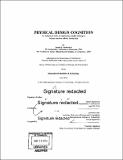| dc.contributor.advisor | Lawrence Sass. | en_US |
| dc.contributor.author | Smithwick, Daniel J., II (Daniel John) | en_US |
| dc.contributor.other | Massachusetts Institute of Technology. Department of Architecture. | en_US |
| dc.date.accessioned | 2017-01-30T19:15:40Z | |
| dc.date.available | 2017-01-30T19:15:40Z | |
| dc.date.copyright | 2016 | en_US |
| dc.date.issued | 2016 | en_US |
| dc.identifier.uri | http://hdl.handle.net/1721.1/106727 | |
| dc.description | Thesis: Ph. D. in Design and Computation, Massachusetts Institute of Technology, Department of Architecture, 2016. | en_US |
| dc.description | Cataloged from PDF version of thesis. | en_US |
| dc.description | Includes bibliographical references (pages 185-188). | en_US |
| dc.description.abstract | In current practices of digital design fabrication, model making is bifurcated into screen based visualization (CAD) and machine based production (CAM), which limits the body's capability of generating creative thought through material interaction. If theories from the field of cognitive science about embodied cognition are true, then there is opportunity to rethink how CAD-CAM technologies can better harness the bodily based thinking involved in physical model making. To study how designers explore ideas when making models an experiment was run in which experienced architects and novice students were asked to construct their dream house out of blocks. The hypothesis was that experienced architects would exhibit physical interactions with the blocks that distinguish them from the novices, thus helping define what may be called physical design cognition. To test this their behaviors were coded in terms of simple robotic actions: adding, subtracting, modifying, and relocating blocks. Architects differed from students along three dimensions. Architects were more controlled using fewer blocks overall and fewer variations; they reported more thoughts about spatial relationships and material constraints; and lastly, they more frequently experimented with multiple block positions within the model. Together these findings suggest that architects physically explore the design space more effectively than students by exploiting body-material interactions. This designerly embodied intelligence is something that robotic technology can support and enhance. As roboticist Rodney Brooks famously said, "The world is its own best model." In other words, designers should not be limited to visualizing a model on a screen before making it physical. Implications for material-based robotic interaction are discussed and a pilot program is presented in which designers interact in real-time with a robotic manipulator arm to make physical models. | en_US |
| dc.description.statementofresponsibility | by Daniel J. Smithwick. | en_US |
| dc.format.extent | 205 pages | en_US |
| dc.language.iso | eng | en_US |
| dc.publisher | Massachusetts Institute of Technology | en_US |
| dc.rights | MIT theses are protected by copyright. They may be viewed, downloaded, or printed from this source but further reproduction or distribution in any format is prohibited without written permission. | en_US |
| dc.rights.uri | http://dspace.mit.edu/handle/1721.1/7582 | en_US |
| dc.subject | Architecture. | en_US |
| dc.title | Physical design cognition : an analytical study of exploratory model making to inform creative robotic interaction | en_US |
| dc.title.alternative | Analytical study of exploratory model making to inform creative robotic interaction | en_US |
| dc.type | Thesis | en_US |
| dc.description.degree | Ph. D. in Design and Computation | en_US |
| dc.contributor.department | Massachusetts Institute of Technology. Department of Architecture | |
| dc.identifier.oclc | 969156066 | en_US |
